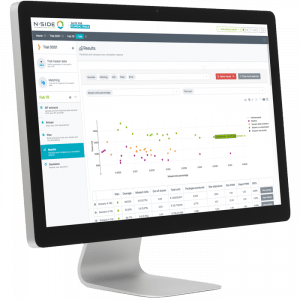Getting clinical supply a seat at the table


Uncovering strategies to increase the collaboration between clinical supply teams and clinical operations
Involving clinical trial supply managers earlier in the process of trial design can be highly beneficial, ensuring that potential supply issues are considered during strategic decisions. With the correct clinical supply optimization solution, clinical supply managers can be empowered with fact-based information to influence early decision-making.
N-SIDE co-facilitated several workshops aimed at uncovering strategies to increase the collaboration between clinical supply teams and clinical operations and to start this partnership earlier. We explore the reasons why many clinical supply managers are being excluded from clinical trial design and the way forward to increase their involvement.
Why don’t clinical supply managers have a seat at the table now?
The clinical trial landscape has been changing in recent years, with costs increasing and drug availabilities decreasing, making supply management more challenging. This can leave supply managers frustrated at not being involved in strategic decision-making, yet being affected by the consequences of these decisions further down the line. If a clinical protocol is not supply-friendly, there could be risk for patients to not receive their medication on time during the trial. Why aren’t clinical trial supply managers involved in clinical trial design?
One of the main barriers to collaboration is the typical hierarchical structure present in many pharmaceutical companies, which places clinical trial supply organization under clinical operations. Rather than allowing supply managers to be involved in strategic decisions, they are often simply handed information on the final study design to work with.
The size of the company can affect opportunities for collaboration. In larger companies with more people and a more rigid structure, it is typically harder for supply managers to get involved in strategy, whereas smaller companies often have more opportunities for collaboration. There is more overlap between roles, allowing everyone to have more involvement in projects and encouraging collaboration between departments.
Budget distribution also has a large impact on involvement in trial design. In the past, clinical trial supply teams typically controlled about 10% of the total trial budget, giving them little influence over decisions. However, more recently this has shifted towards closer to 30%, giving clinical trial supply teams more responsibility and increasing the need for them to be involved earlier in clinical trial design.
Often, supply managers are excluded because their experience has not been considered relevant for clinical protocol design. There is typically a lack of understanding between clinical operations and clinical trial supply teams. Without statistics to substantiate claims about the benefits of collaboration, teams may not understand the need to involve supply managers in trial design.
Of course, every company is at a different stage. In some companies, clinical trial supply managers are not involved at all in clinical protocol design. However, for others, supply managers are starting to have a say. Often, the path to collaboration requires a huge investment of time and many companies are lacking the correct tools to achieve this successfully.
What’s the way forward for improved collaboration?
Given the complex reasons for not involving clinical trial supply managers in early decisions, what strategies can be used to increase collaboration and get the clinical supply team a seat at the table?
In many cases, making people realize that there is a problem in the first place is half the battle. Being able to quantify the risks and costs incurred during “supply unfriendly” protocol designs and executions can be a powerful tool to trigger true communication. For example, studies that include multiple dose levels but do not restrict very unlikely titration patterns can create large problems for drug supply, greatly increasing the risk of running out of stock.
One way to decrease the risk of supply problems is to improve the accuracy of clinical trial forecast metrics. It is important to incorporate data from a large number of studies in order to identify recurring problems, such as late or slow enrolment, and to put measures in place to prevent these from occurring in future trials. Transparency on where assumptions are coming from is crucial in order to ensure reliability and to make sure that predictions are being based on similar previous trials when possible.
The overall goal is to have a supply-friendly protocol while ensuring that the trial remains centred around the needs of the patients. This is not to say that supply issues should be placed above all else, rather that they should be given appropriate weighting in the decision-making process and balanced alongside other needs.

One way to achieve this is to use a validated tool for clinical supply optimization which can provide fact-based information to inform strategic decisions, such as the N-SIDE Suite, an innovative suite of end-to-end clinical trial optimization software. Results obtained from advanced simulation and optimization technologies can be used to quantify the impact of early decisions, improving cross-department communication and increasing collaboration between clinical and supply teams. Using a standard approach, which offers consistent analysis and reporting, is important to improve understanding of information.
Armed with a reliable clinical supply optimization solution, clinical supply managers can ultimately ensure they can get the right drugs to the right place at the right time at lower costs.
Interested to find out more about clinical supply optimization and the N-SIDE Suite for Clinical Trials?




